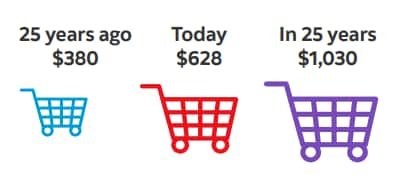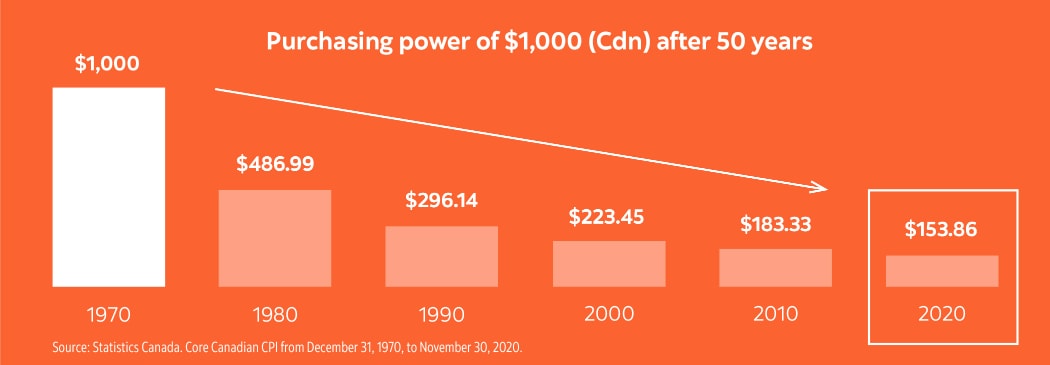If you’ve gone grocery shopping, filled your gas tank or purchased materials for a home renovation lately, you’ve most likely seen and experienced the effects of inflation firsthand. The sharp increases follow last year’s unprecedented economic shutdown, supply chain disruptions and higher costs of raw materials.
Inflation is felt at the cash register
The following illustration shows the value of today’s average monthly household expenditure on food purchased from
stores, versus 25 years ago and 25 years in the future.*

How is inflation measured?
The Consumer Price Index (CPI) is one of the most widely known economic indicators in Canada. The CPI compares, over time, the cost of a fixed basket of goods and services purchased by consumers – such as food, housing and clothing – providing direct insight into consumer price inflation and overall economic conditions. Essentially, the percentage change in the price of the basket is used as an estimate of the amount of inflation in the economy overall.
What are the effects of inflation?
The most common effect of inflation is the erosion of purchasing power – in other words, when prices rise, your money buys less. See the simple illustration below, which shows the diminished purchasing power of $1,000 after 50 years – from 1970 to 2020.

Tip: Keep in mind the value of goods, not just in today’s dollars, but in the future as well.
When saving for a long-term goal, we’re planning for the future, while being very much rooted in the present. Often the dollar value assigned to our finish line is the cost of items today – and doesn’t account for the impact that inflation can have on the purchasing power of our savings over time.
The impact of inflation

The impact of inflation on long-term savings
The negative impact that inflation has on your savings over time is an ever-present, but often overlooked risk when investing. While the impact of inflation on your investments isn’t usually felt in the short term, its impact can slowly erode the purchasing power of your long-term savings. As the price of goods and services increases over time, a higher amount of savings is required to maintain the same level of purchasing power in the future (ex. retirement).
What you can do to stay ahead of inflation
Investing in a balanced portfolio, containing a mix of stocks and bonds, has a greater potential to outpace inflation and help build wealth over time. This is due in large part to the strong returns earned by stocks, which have historically beaten inflation by a large margin. Your portfolio’s asset mix of stocks and bonds is a key determinant of meeting your long-term investment goals. Think of bonds for income potential and as a shock absorber for your portfolio during stock market downturns. By contrast, stocks are the growth engine of your portfolio, with a higher allocation offering greater long-term return potential, but with a corresponding increase in risk.
On the other hand, if your investment portfolio holds a portion of assets in cash for a considerable amount of time, the minimal returns provided by cash may drag down your overall investment portfolio performance (see the portfolio examples below).
Cash and its long-term impact on your portfolio1
In the following scenario, we invested $10,000 in three different ways over a 10-year period:
- fully invested in a balanced portfolio
- 50% in a balanced portfolio and 50% cash
- 100% in cash
Based on a $10,000 initial investment over a 10-year period (January 2010 to December 2020)
As the graph below shows, if you keep your long-term savings in cash, not only will you be missing out on greater growth potential for your money, but your cash holdings may not even keep pace with inflation, leaving you with a negative real return.

Minimizing the effects of inflation
No one can completely avoid the effects of inflation. However, a sound investment strategy as part of your financial plan can help you maintain your purchasing power and standard of living in retirement.
Scotiabank offers a wide range of portfolio solutions that are continuously adjusted to control for a variety of risks, including inflation risk.
How do Scotia Portfolio Solution protect against inflation?
Our multi-asset portfolios invest in market segments and asset classes (ex. stocks, bonds and cash) that aim to deliver total returns above and beyond the level of inflation over the long term. Inflation is an important consideration when it comes to stock selection by our portfolio managers. We strive to invest in companies that have pricing power for sustainable operating margins, companies that are leaders in their industries, that generate positive cash flow and are delivering a high level of return on invested capital.
By investing in different industries and asset classes, we benefit from the diversification of how they react to changes in inflation rates, which is important from a risk-management standpoint. By investing in a well-diversified portfolio, not only are we helping to protect the purchasing power of the investment, we expect to be compensated with a premium for taking the risk.
*Statistics Canada (2019). Value of goods today based on average expenditure per household on food purchased from stores, expressed as a monthly figure in CAD rounded to the nearest dollar (Table 11-10-0125-01). Value of goods 25 years ago calculated using the Bank of Canada Inflation Calculator. Value of goods in 25 years assumes an inflation rate of 2% compounded annually. For illustrative purposes only.
1. Source: Morningstar. The example is hypothetical and for illustrative purposes only. It is not possible to invest directly in an index. Assumes reinvestment of all income and no transaction costs or taxes. Value of investment calculated using a starting value of $10,000 and annual compounded returns from January 1, 2010 – December 31, 2020. Assumes investment in a balanced portfolio weighted 25% S&P/TSX Composite TR Index, 50% FTSE Canada Universe Bond Index, and 25% MSCI World GR Index. Cash is assumed to have been invested in FTSE Canada 91 Day T-Bill Index.


